I had an urge this week to write about doing laundry in ancient Rome.
Why?
Because our laundry machine broke down and we are waiting to get it repaired.
As with many things, history geek that I am, it reminded me of ancient history. When I need to clean some piece of clothing without a machine, I use the sink with fresh running water and soap. If you lived in the 19th century, you might have used an old fashioned wash-board with some lye soap – plunge and scrub, plunge and scrub!
But the Romans didn’t have soap, or wash-boards.
So what was a Roman to do when their tunica or stola needed a good cleaning?
Oddly enough, they did not wash their clothes at home.
They took them to a fullonica, the ancient version of a laundry mat or dry cleaners.
Fullers, or fullones, were washers and scourers of clothing and new cloth, and they did a pretty good business in ancient Rome.
I mean, those streets were dirty! And with all the olive oil and garum stains on their clothing, their clothes would have needed a good scrubbing.
There were apparently many fullonicae in ancient Rome and other towns such as Pompeii and Ostia, but how did fullones get the clothes of their fellow citizens clean without any soap?
Why, with human pee of course!
Ok, I’m sensationalizing this a bit, but urine was certainly a part of the process.
Basically, there were three steps to doing laundry properly in the Roman world.
First, the clothing or new cloth had to be washed by the fuller, the fullo.
This was done by putting the clothes in a small tub full with a mixture of water, nitrum or fuller’s earth (known as creta fullonia), some alkali elements, and of course, urine. Water and urine appear to have been the main ingredients of this ancient detergent.
But how did a large prosperous fullonica get enough urine to do the laundry of Rome or Ostia? Well, they placed jars on street corners around the neighbourhood where they operated so that passersby could make a…donation.
I’m guessing the jars near tabernae might have been the most useful. You have to feel for the poor sod whose job it was to go and bring the full jars of urine back to the fullonica through the busy streets of Rome. Maybe people gave him a wide berth so as not to get splashed?
At any rate, once the clothes were in this cleaning mixture, the fuller would get in barefoot and stomp away, over and over, until the clothes were scrubbed of oil, dirt, and grease. This little dance was known as the saltus fullonicus, or the ‘fuller’s jump’.
The next step in the process was to rinse the clothing or cloth. This was done in a series of larger, interconnected wash basins into which poured fresh running water from the town water supply.
The fullo would start at the the dirty end, near the spout where the water exited, and then move up the basins toward the clean end where the water came out.
The final stage involved brushing the clothing (usually wool) with either thistly plants, or the skin of a hedgehog (insert sad face here). They were then hung to dry on a large upside-down wicker basket work with sulphur placed beneath it so as to allow the fumes to whiten the clothes.
High-end fullones, as part of this final stage in the process, might also have rubbed in cimolian, a fine white earth that was supposed to whiten the garment even further.
Once this was all done, your toga was ready to wear to your next imperial banquet!

Caesar and Vorenus had to clean their togas somewhere! (screen shot from HBO’s fantastic series, ROME)


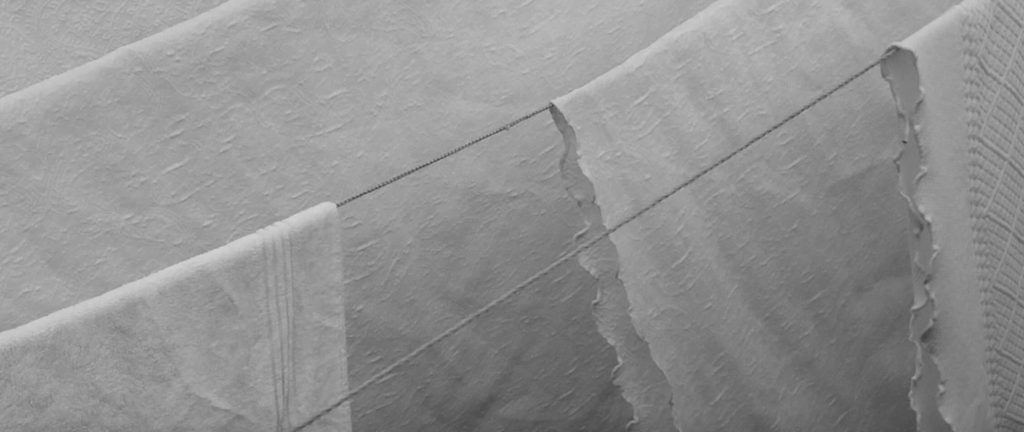

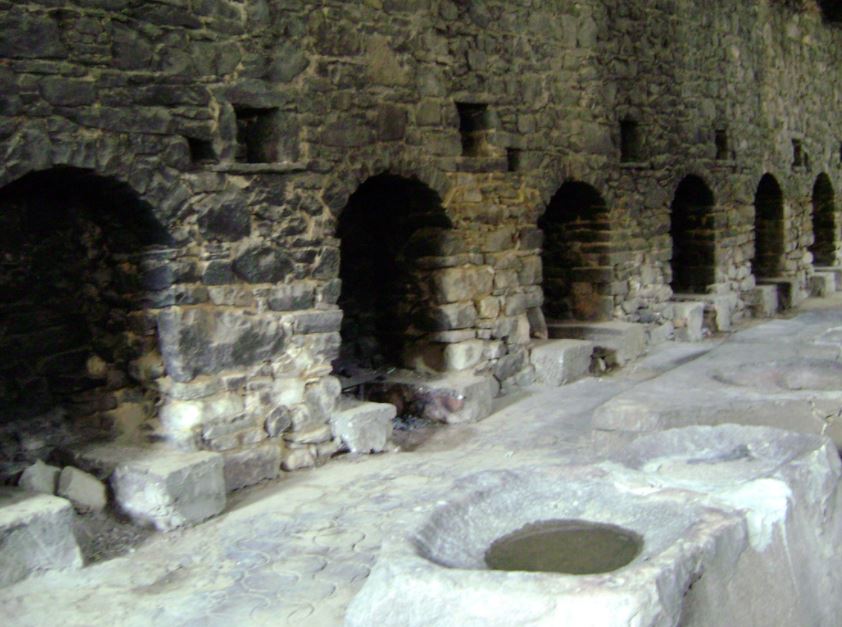
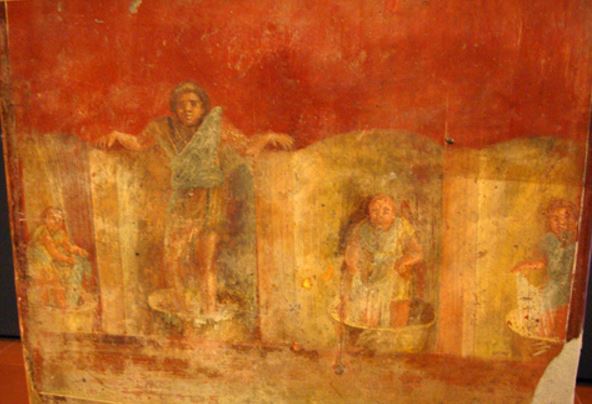

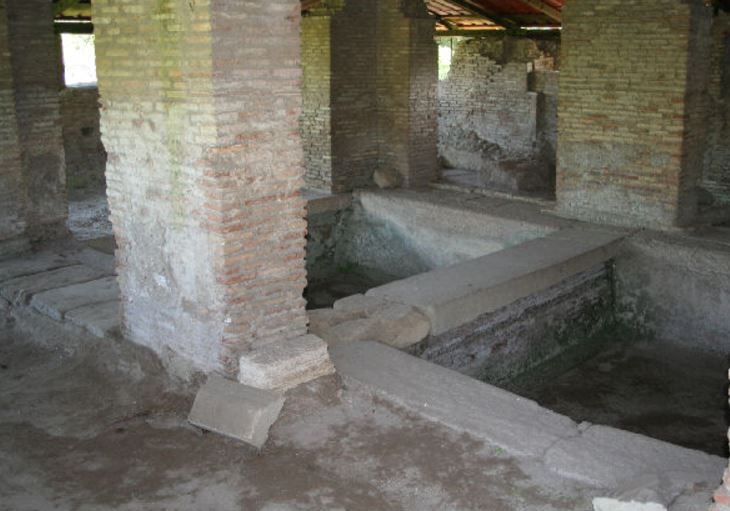
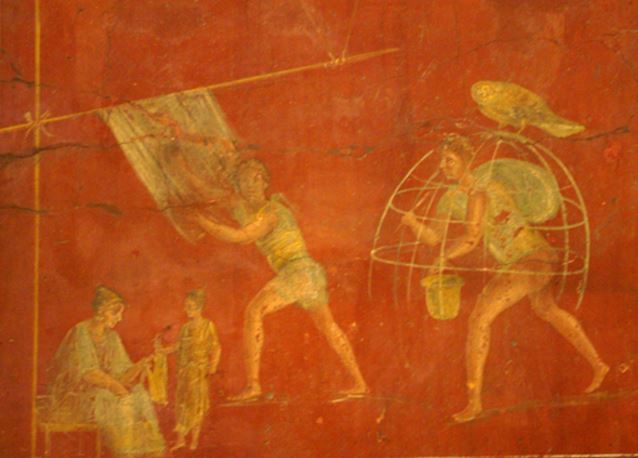

An excellent description of “fulling” as it was used in the wool industry in Devon can be found on the website below. The concept is the same although it morphed from men stepping on the cloth to water-driven mills hammering the cloth, not to clean it but to further process the wool, making it more fit for wearing. There were numerous fulling mills up and down the River Exe near Tiverton.
http://www.witheridge-historical-archive.com/fulling.htm
Cheers, Bill! Glad you liked the post. I wonder if they used urine in the Devonshire fulling industry in the late Middle Ages? I remember being told about the large number of mills in Tiverton for the industry there. Thanks for sharing the link with everyone! I am missing Tiverton 🙁 Will have to go back soon! 🙂
Hi Bill, thanks for the site to go to for English fulling. History is so interesting! The Scots did it too in days gone by but often the women of the village or clan fulled the cloth. Here’s a a site that gives the description of how they did it: https://greatscotblog.com/2014/03/10/great-scot-all-about-waulking-or-milling-frolics/
This site is a blog about the books from Outlander that is now on Stars with it’s third series starting in Sept. One of the first shows from the first series shows the women ‘fulling’ or waulking cloth singing while they did it.
Bonnie Miller
Hi Adam, wonderful write-up about laundry business in Rome. I can visualize the fullers going through various stages of cleaning togas. Is ‘fullo’ singular for Fullones?
Best wishes, keep writing and hopefully your washing-machine will start working soon.
Cheers A. David 🙂 Good to hear from you. It is quite a visual, isn’t it. I can’t imagine the smell in the fullonica (well, I suppose I can imagine it – I just don’t want to!). And yes, ‘fullo’ is the singular. Hope your own writing is going well! 🙂
The ammonia in the urine helped clean the clothes. I love the ancient use of urine in their toothpaste also to keep their teeth white! I’ve read where the practice of urine based toothpaste and mouthwashes lasted into the 1700’s. Don’t even want to go into what it tasted like! Wasn’t urine also used in tanning hides?
As always, you’ve given us something to think about let alone be so happy we live in the age when we do.
An avid Fan,
Bonnie Miller
My goodness! I didn’t know that about toothpaste, Bonnie… I shudder to think about it 😉 I know back in Greece of a relative who would rub garlic cloves on his teeth everyday to keep them healthy. When he passed he had all of his natural teeth. But I suppose you had better like garlic if you were around him 😉 Someone also told me recently that horse urine was used birth control pills back in the 1950s and 60s! I guess there are many more uses for urine than laundry and jelly fish stings! Thank you for your comment, Bonnie 🙂
A fascinating (as usual) into the process. I’m guessing that this was a fairly expensive process (dry cleaning ain’t cheap even these days) and that you’d need to be fairly well off to afford it. Still, I guess the builder’s labourer wouldn’t have had much use for a snow-white toga, anyway!
Thank you Lin. I do wonder if more people did laundry at home that my research led me to believe. I did read that many took their clothes to the fullonica for washing, but still. For the lower classes, it must have been costly. Perhaps the clothes of folks in the Subura were dirty but clean 😉 Thank you for your comment 🙂
In studying up on laundry techniques, I was a bit surprised that it’s not the detergent that cleans, but the agitation of the washer. so we can go back to stomping and slapping our clothes on ricks and save money and electricity!
Sounds like a plan, Jean! LOL! If electricity and power grids ever go down in a giant EMP, then we’ll all be doing that. Now we know and are prepared 🙂 Cheers for your comment!
Very good report !